Experiments on Cavitation Control around a Cylinder Using Biomimetic Riblets
Abstract
:1. Introduction
2. Experimental Setup
3. Results and Discussion
3.1. Cavitation Dynamics
3.2. Morphology of Riblets
3.3. Effect of Reynolds Number
4. Conclusions
Author Contributions
Funding
Data Availability Statement
Acknowledgments
Conflicts of Interest
References
- Reisman, G.; Wang, Y.; Brennen, C. Observations of shock waves in cloud cavitation. J. Fluid Mech. 1998, 355, 255–283. [Google Scholar] [CrossRef]
- Dular, M.; Bachert, B.; Stoffel, B.; Sirok, B. Relationship between cavitation structures and cavitation damage. Wear 2004, 257, 1176–1184. [Google Scholar] [CrossRef]
- Haosheng, C.; Yongjian, L.; Darong, C.; Jiadao, W. Experimental and numerical investigations on development of cavitation erosion pits on solid surface. Tribol. Lett. 2007, 26, 153159. [Google Scholar] [CrossRef]
- Patella, R.; Choffat, T.; Reboud, J.; Archer, A. Mass loss simulation in cavitation erosion: Fatigue criterion approach. Wear 2013, 300, 205–215. [Google Scholar] [CrossRef]
- Kadivar, E.; el Moctar, O.; Sagar, H. Experimental study of the influence of mesoscale surface structuring on single bubble dynamics. Ocean Eng. 2022, 260, 111892. [Google Scholar] [CrossRef]
- Lin, Y.; Kadivar, E.; el Moctar, O.; Neugebauer, J.; Schellin, T.E. Experimental investigation on the effect of fluid–structure interaction on unsteady cavitating flows around flexible and stiff hydrofoils. J. Phys. Fluids 2022, 34, 083308. [Google Scholar] [CrossRef]
- Franc, J.; Micheal, J. Fundamentals of Cavitation; Kluwer Academic Publishers: Dordrecht, The Netherlands, 2005. [Google Scholar]
- Kadivar, E.; el Moctar, O.; Skoda, R.; Löschner, U. Experimental study of the control of cavitation-induced erosion created by collapse of single bubbles using a micro structured riblet. Wear 2021, 486–487, 204087. [Google Scholar] [CrossRef]
- Arndt, R.E.; Ippen, A.T. Cavitation near Surfaces of Distributed Roughness; Massachusetts Institute of Technology: Cambridge, MA, USA, 1967. [Google Scholar]
- Phan, T.-H.; Kadivar, E.; Nguyen, V.-T.; el Moctar, O.; Park, W.-G. Thermodynamic effects on single cavitation bubble dynamics under various ambient temperature conditions. Phys. Fluids 2022, 34, 023318. [Google Scholar] [CrossRef]
- Venning, J.A.; Pearce, B.W.; Brandner, P.A. Nucleation effects on cloud cavitation about a hydrofoil. J. Fluid Mech. 2022, 947, A1. [Google Scholar] [CrossRef]
- Yuan, G.Y.; Ni, B.Y.; Wu, Q.G.; Xue, Y.Z.; Han, D.F. Ice breaking by a high-speed water jet impact. J. Fluid Mech. 2022, 934, A1. [Google Scholar] [CrossRef]
- Yuan, G.; Ni, B.; Wu, Q.; Lu, W.; Xue, Y. Experimental study on ice breaking by a cavitating water jet in a Venturi structure. Appl. Therm. Eng. 2024, 239, 122095. [Google Scholar] [CrossRef]
- Kadivar, E. Experimental and Numerical Investigations of Cavitation Control Using Cavitating-Bubble Generators. Ph.D. Thesis, University of Duisburg-Essen, Duisburg, Germany, 2020. [Google Scholar]
- Li, Q.; Franc, J.; Michel, J. Partial Cavities: Global Behavior and Mean Pressure. J. Fluids Eng. 1993, 115, 243–248. [Google Scholar]
- Callenaere, M.; Franc, J.; Michel, J.; Rionde, M. The cavitation instability induced by the development of a re-entrant jet. J. Fluid Mech. 2001, 444, 223–256. [Google Scholar] [CrossRef]
- Stutz, B.; Reboud, J.-L. Two-phase flow structure of sheet cavitation. Phys. Fluids 1997, 9, 3678–3686. [Google Scholar] [CrossRef]
- Leroux, J.; Coutier-Delgosha, O.; Astolfi, A. A joint experimental and numerical study of mechanism associated to instability of partial cavitation on two-dimensional hydrofoil. Phys. Fluids 2005, 17, 052101. [Google Scholar] [CrossRef]
- Leroux, J.; Astolfi, J.; Billard, J. An Experimental Study of Unsteady Partial Cavitation. J. Fluids Eng. 2004, 126, 94–101. [Google Scholar] [CrossRef]
- Ganesh, H.; Mäkiharju, S.; Ceccio, S. Bubbly shock propagation as a mechanism for sheet-to-cloud transition of partial cavities. J. Fluid Mech. 2016, 802, 37–78. [Google Scholar] [CrossRef]
- Ghahramani, E.; Ström, H.; Bensow, R.E. Numerical simulation and analysis of multi-scale cavitating flows. J. Fluid Mech. 2021, 922, A22. [Google Scholar] [CrossRef]
- Kadivar, E.; Ochiai, T.; Iga, Y.; el Moctar, O. An experimental investigation of transient cavitation control on a hydrofoil using hemispherical vortex generators. J. Hydrodyn. 2020, 33, 1139–1147. [Google Scholar] [CrossRef]
- Kadivar, E.; Timoshevskiy, M.; Nichik, M.; el Moctar, O.; Schellin, T.; Pervunin, K. Control of unsteady partial cavitation and cloud cavitation in marine engineering and hydraulic systems. Phys. Fluids 2020, 32, 052108. [Google Scholar] [CrossRef]
- Long, X.; Cheng, H.; Ji, B.; Arndt, R.E.A.; Peng, X. Large eddy simulation and Euler–Lagrangian coupling investigation of the transient cavitating turbulent flow around a twisted hydrofoil. Int. J. Multiph. Flow 2018, 100, 41–56. [Google Scholar] [CrossRef]
- Pelz, P.; Keil, T.; Groß, T.F. The transition from sheet to cloud cavitation. J. Fluid Mech. 2017, 817, 439–454. [Google Scholar] [CrossRef]
- Wang, Z.; Cheng, H.; Ji, B. Euler–Lagrange study of cavitating turbulent flow around a hydrofoil. Phys. Fluids 2021, 33, 112108. [Google Scholar] [CrossRef]
- Wang, Z.; Cheng, H.; Ji, B.; Peng, X. Numerical investigation of inner structure and its formation mechanism of cloud cavitating flow. Int. J. Multiphase Flow 2023, 165, 104484. [Google Scholar] [CrossRef]
- Matsudaira, Y.; Gomi, Y.; Oba, R. Characteristics of bubble-collapse pressures in a karman-vortex cavity. JSME Int. J. 1992, 35, 179–185. [Google Scholar] [CrossRef]
- Saito, Y.; Sato, K. Cavitation bubble collapse and impact in the wake of a circular cylinder. In Proceedings of the Fifth International Symposium on Cavitation, Osaka, Japan, 1–4 November 2003; pp. 3–8. [Google Scholar]
- Kumar, P.; Chatterjee, D.; Bakshi, S. Experimental investigation of cavitating structures in the near wake of a cylinder. Int. J. Multiph. Flow 2017, 89, 207–217. [Google Scholar] [CrossRef]
- Geike, T. Bubble dynamics-based modeling of the cavitation dynamics in lubricated contacts. Facta Univ. Ser. Mech. Eng. 2021, 19, 115–124. [Google Scholar] [CrossRef]
- Gnanaskandan, A.; Mahesh, K. Numerical investigation of near-wake characteristics of cavitating flow over a circular cylinder. J. Fluid Mech. 2016, 790, 453–491. [Google Scholar] [CrossRef]
- Dobroselsky, K. Cavitation streamlining of a round cylinder in the critical range. J. Phys. Conf. Ser. 2020, 1677, 012056. [Google Scholar] [CrossRef]
- Brandao, F.; Bhatt, M.; Mahesh, K. Numerical study of cavitation regimes in flow over a circular cylinder. J. Fluid Mech. 2019, 885, A19. [Google Scholar] [CrossRef]
- Gu, F.; Huang, Y.; Zhang, D. Cavitation of Multiscale Vortices in Circular Cylinder Wake at Re = 9500. J. Mar. Sci. Eng. 2021, 9, 1366. [Google Scholar] [CrossRef]
- Sadri, M.; Kadivar, E. Numerical investigation of the cavitating flow and the cavitation-induced noise around one and two circular cylinders. Ocean. Eng. 2023, 277, 114178. [Google Scholar] [CrossRef]
- Zhang, A.M.; Li, S.-M.; Cui, P.; Li, S.; Liu, Y.-L. A unified theory for bubble dynamics. Phys. Fluids 2023, 35, 033323. [Google Scholar] [CrossRef]
- Custodio, D.; Henoch, C.; Johari, H. Cavitation on hydrofoils with leading edge protuberances. Ocean Eng. 2018, 162, 196–208. [Google Scholar] [CrossRef]
- Hao, J.; Zhang, M.; Huang, X. The influence of surface roughness on cloud cavitation flow around hydrofoils. Acta Mech. Sin. 2018, 34, 10–21. [Google Scholar] [CrossRef]
- Zhao, W.; Wang, G. Research on passive control of cloud cavitation based on a bionic fin-fin structure. Eng. Comput. 2020, 37, 863–880. [Google Scholar] [CrossRef]
- Zhang, L.; Chen, M.; Shao, X. Inhibition of cloud cavitation on a flat hydrofoil through the placement of an obstacle. Ocean Eng. 2018, 155, 1–9. [Google Scholar] [CrossRef]
- Che, B.; Chu, N.; Schmidt, S.; Cao, L.; Likhachev, D.; Wu, D. Control effect of micro vortex generators on leading edge of attached cavitation. Phys. Fluids 2019, 31, 044102-1–044102-12. [Google Scholar] [CrossRef]
- Che, B.; Chu, N.; Cao, L.; Schmidt, S.; Likhachev, D.; Wu, D. Control effect of micro vortex generators on attached cavitation instability. Phys. Fluids 2019, 31, 064102-1–064102-11. [Google Scholar] [CrossRef]
- Kadivar, E.; Timoshevskiy, M.; Pervunin, K.; el Moctar, O. Cavitation control using cylindrical cavitating-bubble generators (CCGS): Experiments on a benchmark cav2003 hydrofoil. Int. J. Multiph. Flow 2020, 125, 103186. [Google Scholar] [CrossRef]
- Kadivar, E.; el Moctar, O. Investigation of cloud cavitation passive control method for hydrofoils using Cavitating-bubble Generators (CGs). In Proceedings of the 10th International Symposium on Cavitation, Baltimore, MD, USA, 14–16 May 2018. [Google Scholar]
- Simanto, R.; Hong, J.; Kim, K.; Ahn, B.; Shin, S. Experimental investigation on cavitation and induced noise of two-dimensional hydrofoils with leading-edge protuberances. Phys. Fluids 2022, 34, 124115. [Google Scholar] [CrossRef]
- Yu, F.; Zhang, Y.; Liu, H.; Zhou, Q. Experimental and numerical investigation of cavitation control with porous material on the hemisphere cylinder. J. Ocean. Eng. 2022, 266, 112984. [Google Scholar] [CrossRef]
- Kawamura, T.; Hiwada, M.; Hibino, T.; Mabuchi, I.; Kumada, M. Flow around a Finite Circular Cylinder on a Flat Plate: Cylinder height greater than turbulent boundary layer thickness. Bull. JSME 1984, 27, 2142–2151. [Google Scholar] [CrossRef]
- Kitagawa, T.; Fujino, Y.; Kimura, K.; Mizuno, Y. Wind pressures measurement on end-cell-induced vibration of a cantilevered circular cylinder. J. Wind Eng. Ind. Aerodyn. 2002, 90, 395–405. [Google Scholar] [CrossRef]
- Graf, W.H.; Yulistiyanto, B. Experiments on Flow around a cylinder; the velocity and vorticity fields. J. Hydraul. Res. 1998, 36, 637–653. [Google Scholar] [CrossRef]
- Park, C.W.; Lee, S.J. Free end effects on the near wake flow structure behind a finite circular cylinder. J. Wind Eng. Ind. Aerodyn. 2000, 88, 231–246. [Google Scholar] [CrossRef]
- van Rijsbergen, M. A review of sheet cavitation inception mechanisms. In Proceedings of the IS-ROMAC2016—International Symposium on Transport Phenomena and Dynamics of Rotating Machinery, Honolulu, HI, USA, 10–16 April 2016. [Google Scholar]
- Bixler, G.D.; Bhushan, B. Fluid drag reduction with shark-skin riblet inspired microstructured surfaces. J. Adv. Funct. Mater. 2013, 23, 4507–4528. [Google Scholar] [CrossRef]
- Lulekar, S.S.; Ghassemi, P.; Alsalih, H.; Chowdhury, S. Adaptive-fidelity design automation framework to explore bioinspired surface riblets for drag reduction. AIAA J. 2021, 59, 880–892. [Google Scholar] [CrossRef]
- Wang, Y.; Huang, Y.; Fu, S. On the tip sharpness of riblets for turbulent drag reduction. J. Acta Mech. Sin. 2022, 38, 321389. [Google Scholar] [CrossRef]
- Lee, S.J.; Lee, S.H. Flow field analysis of a turbulent boundary layer over a riblet surface. Exp. Fluids 2001, 30, 153–166. [Google Scholar] [CrossRef]
- Goldstein, D.; Handler, R.; Sirovich, L. Direct numerical simulation of turbulent flow over a modelled riblet covered surface. J. Fluid Mech. 1995, 302, 333–376. [Google Scholar] [CrossRef]
- Dean, B.; Bharat, B. Shark-skin surfaces for fluid-drag reduction in turbulent flow: A review. Phil. Trans. R. Soc. A 2010, 368, 4775–4806. [Google Scholar] [CrossRef] [PubMed]


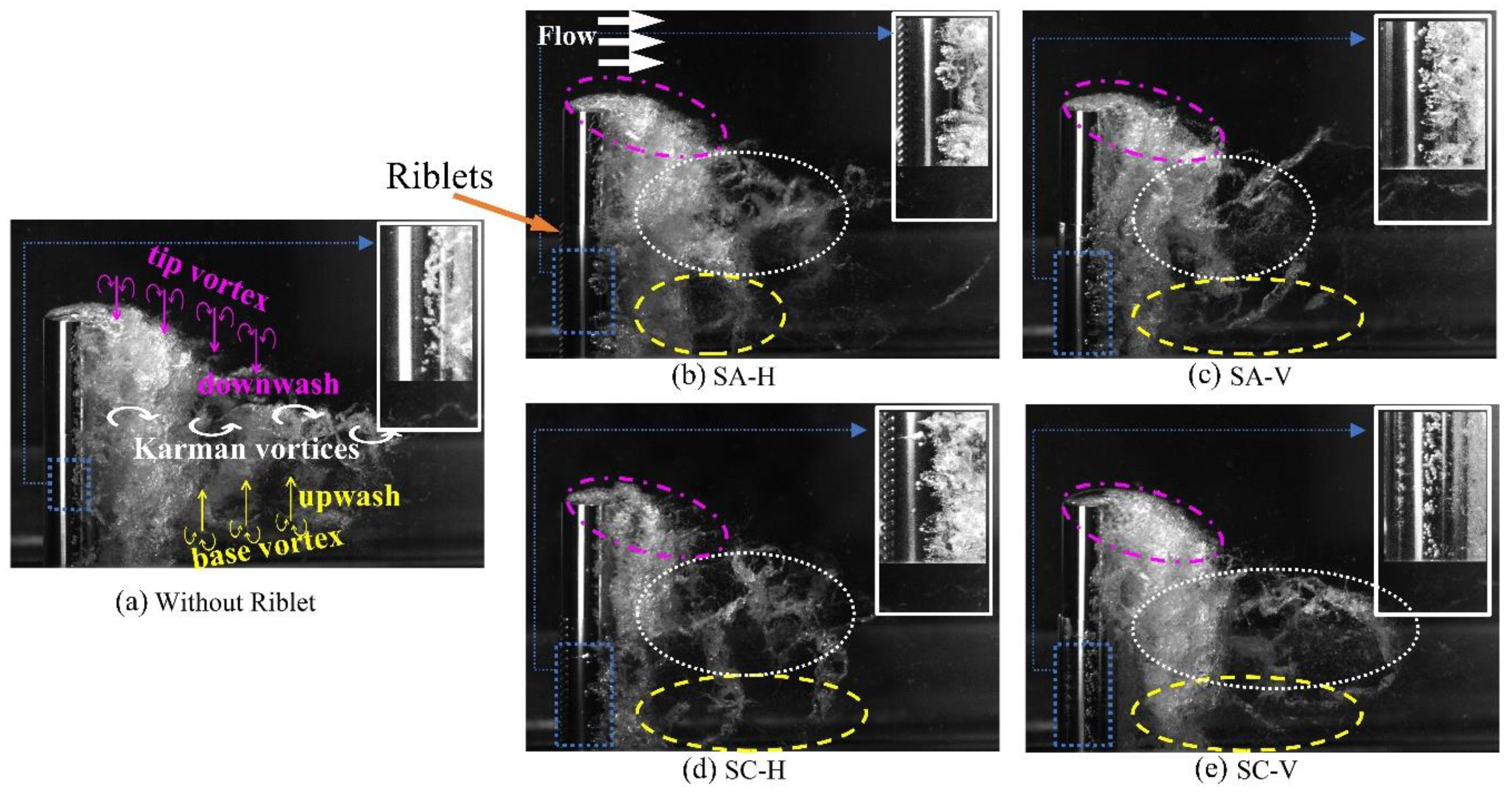
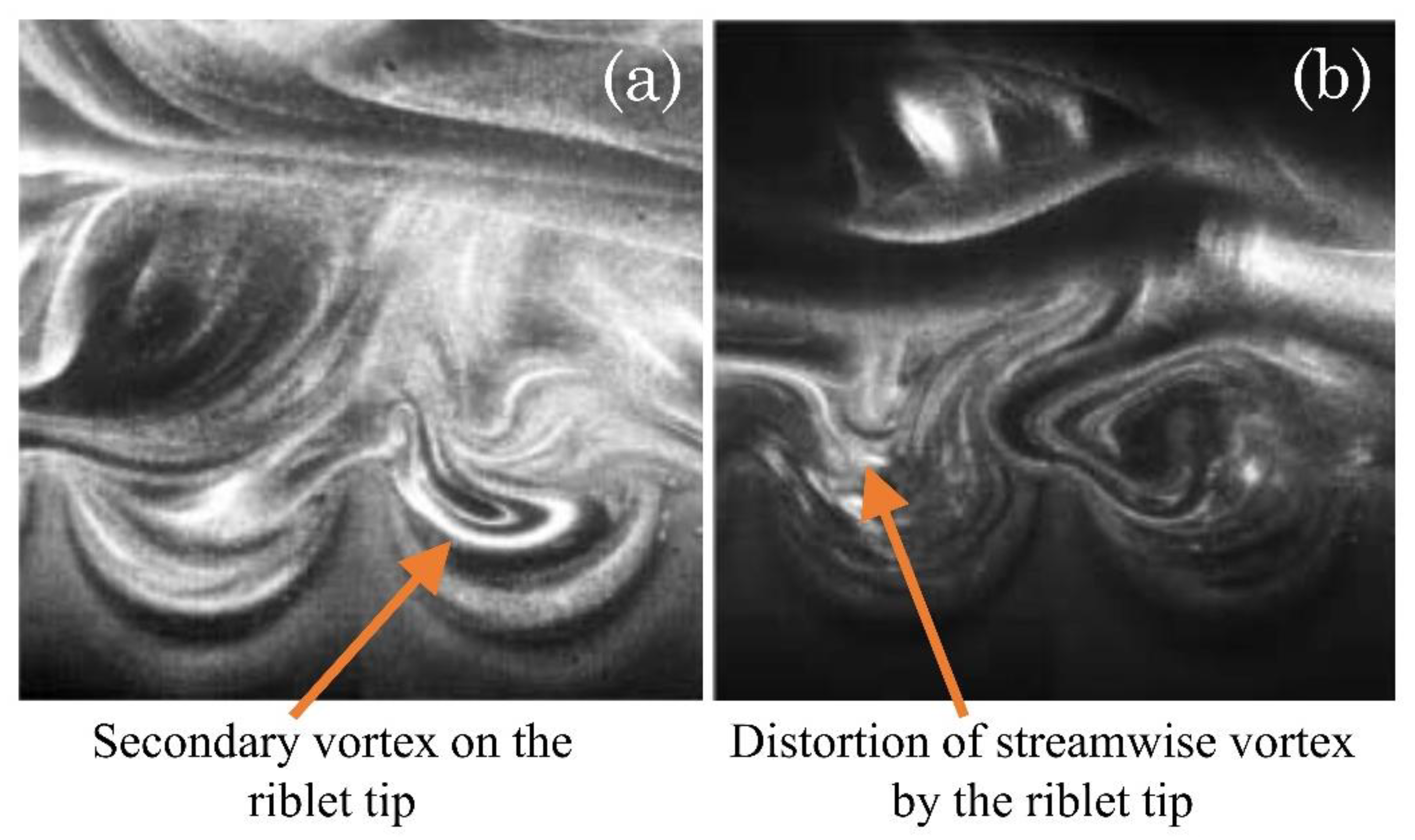


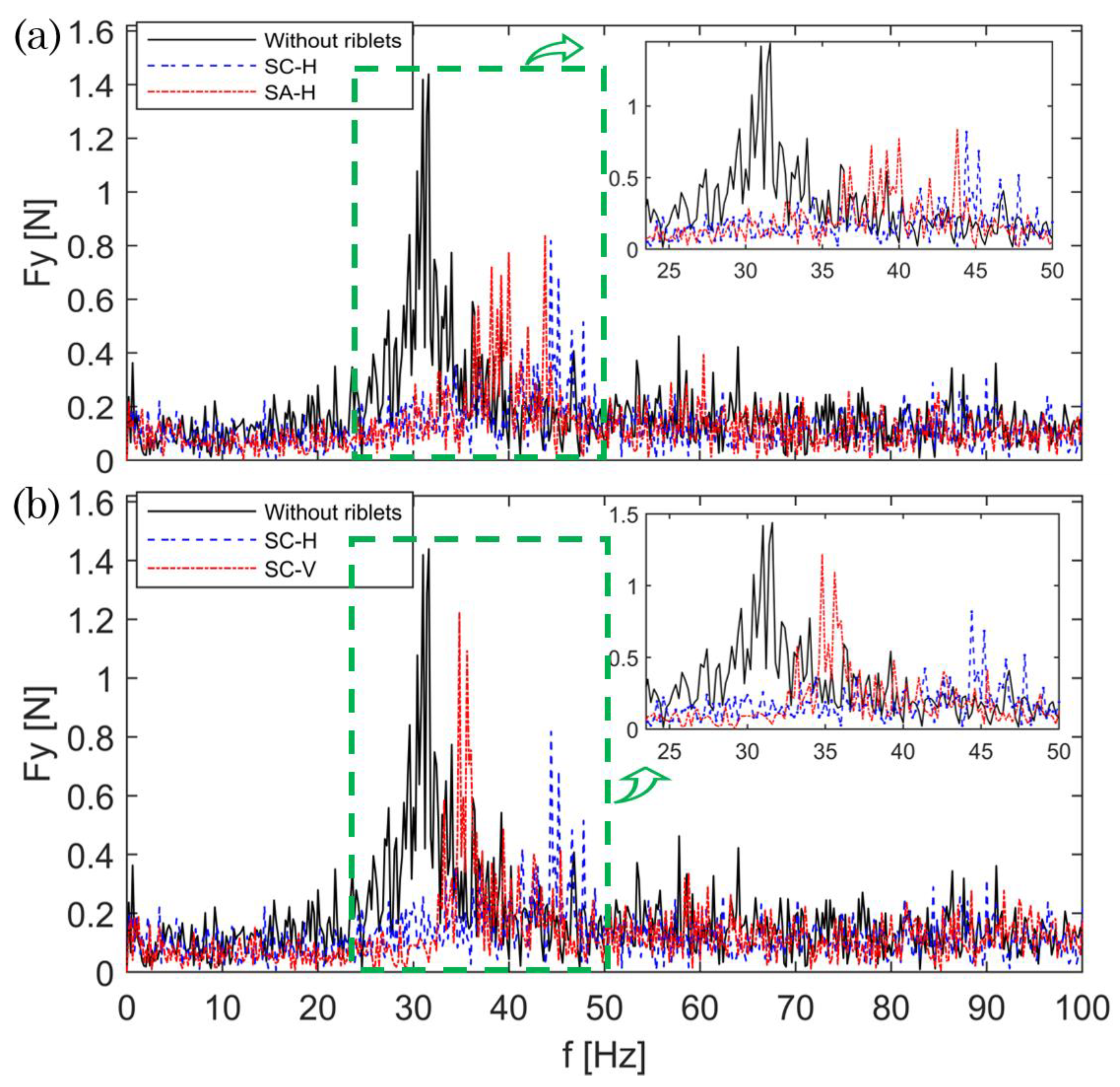
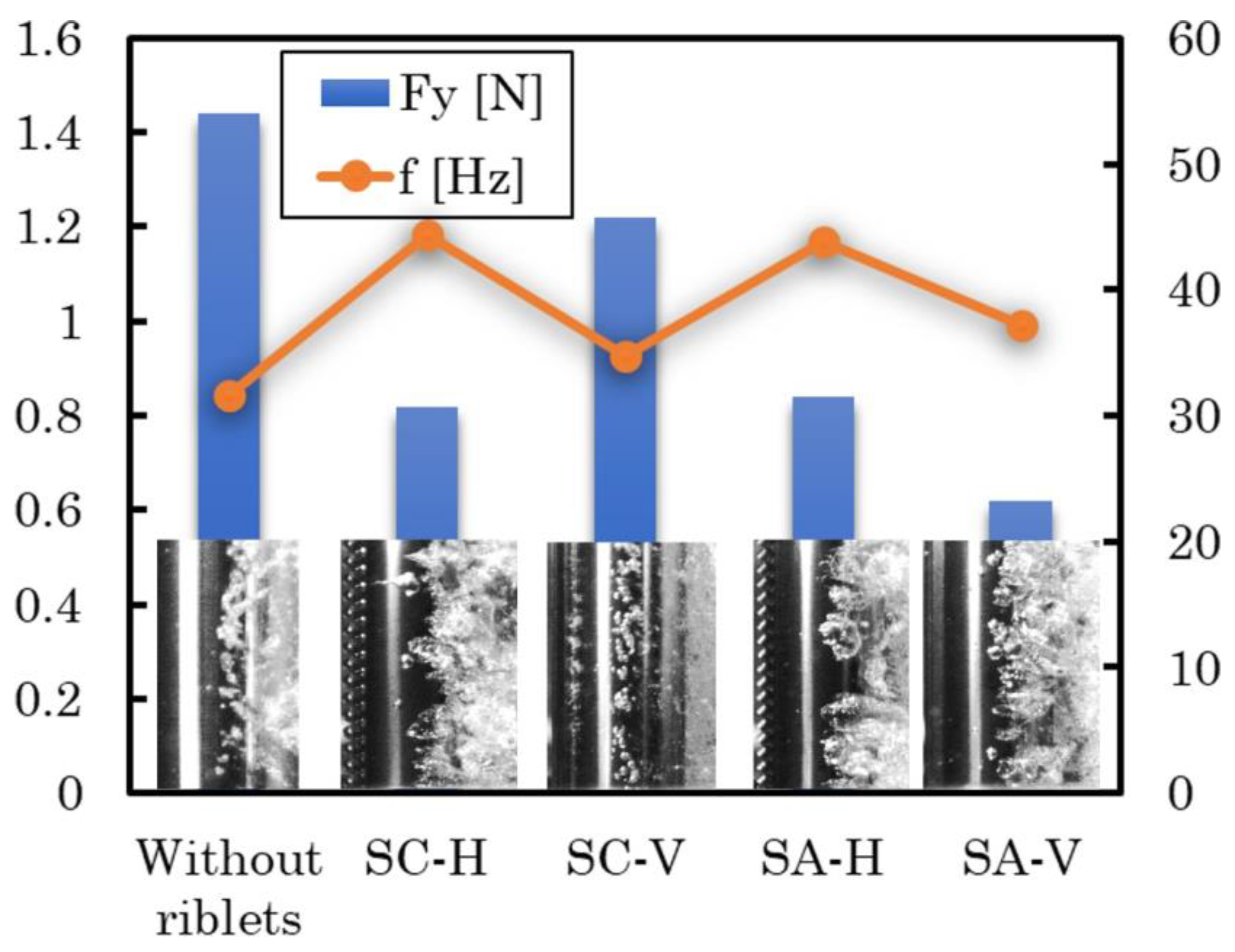
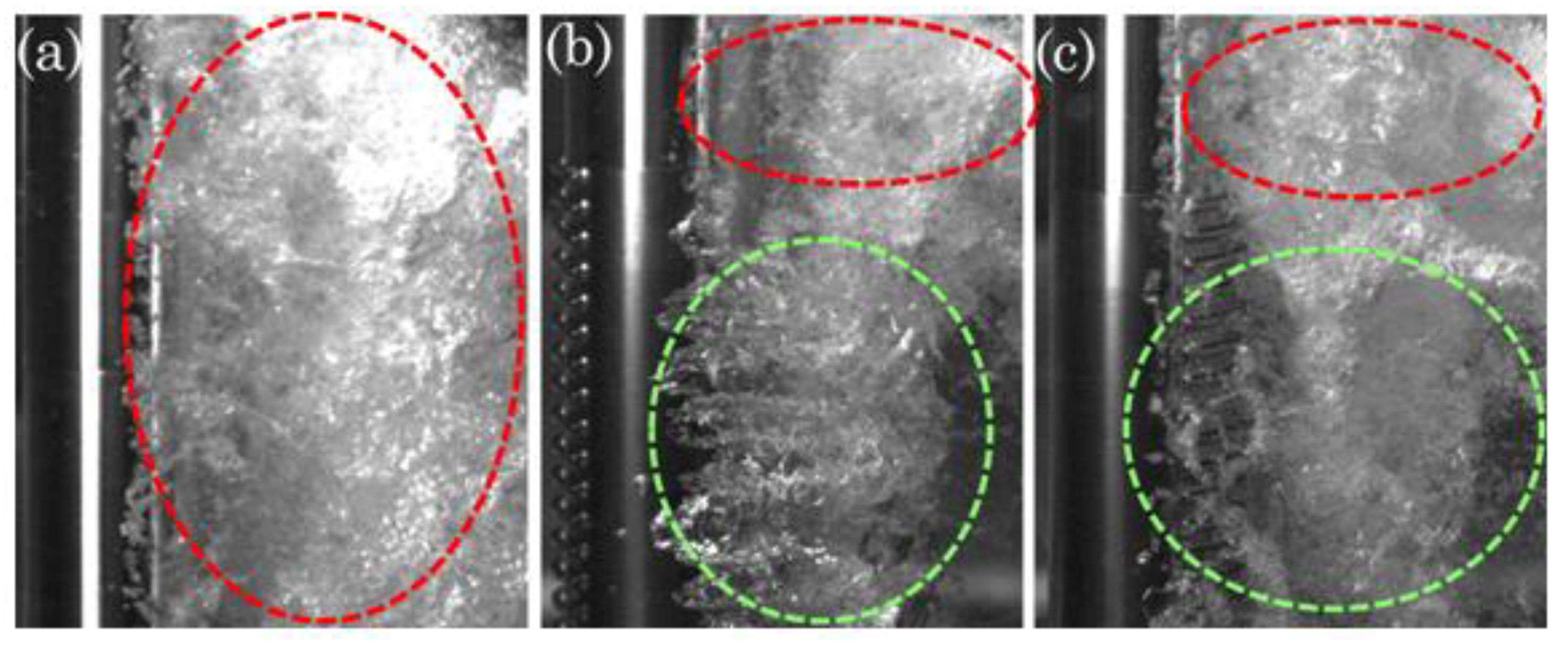

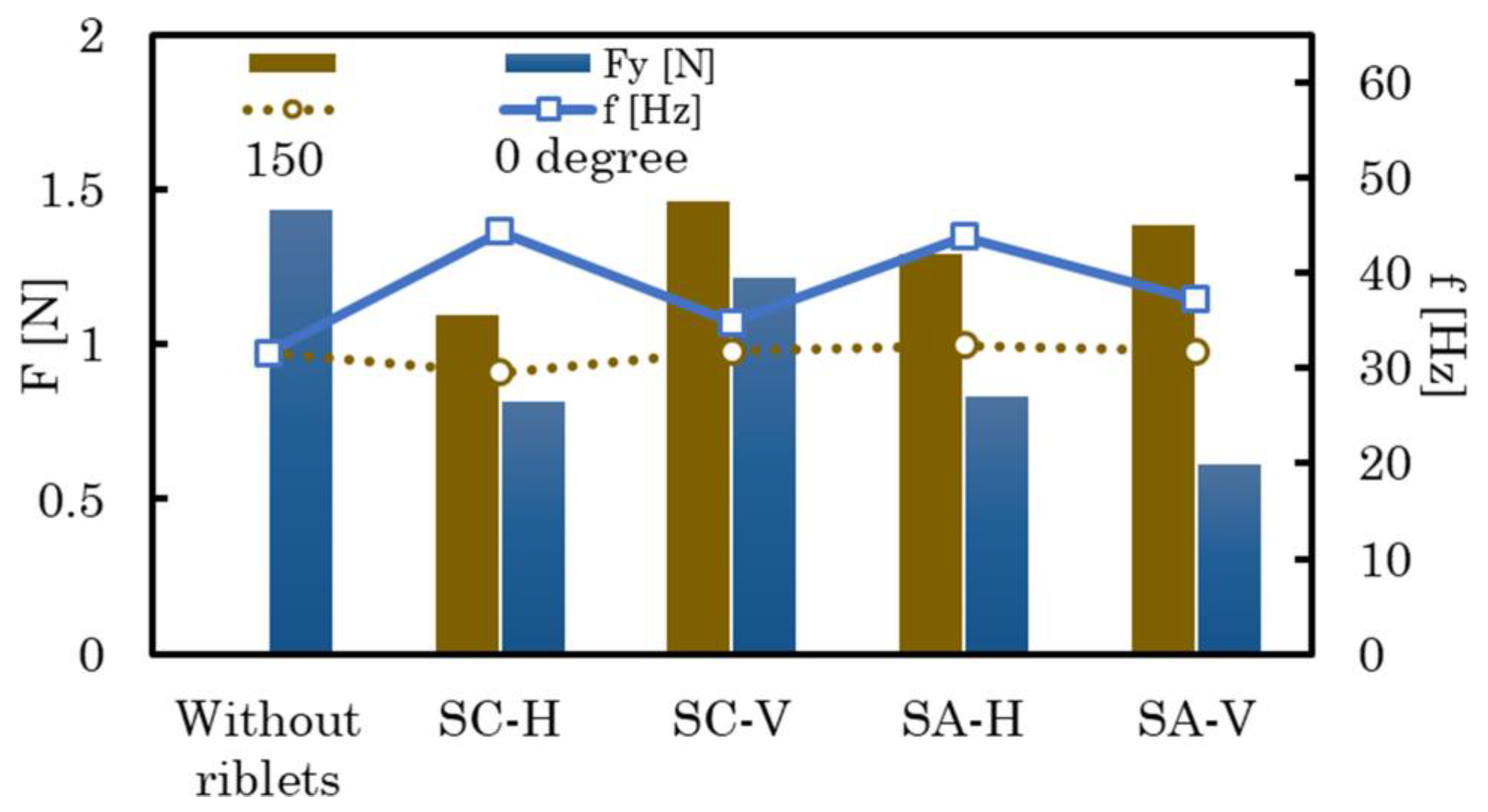
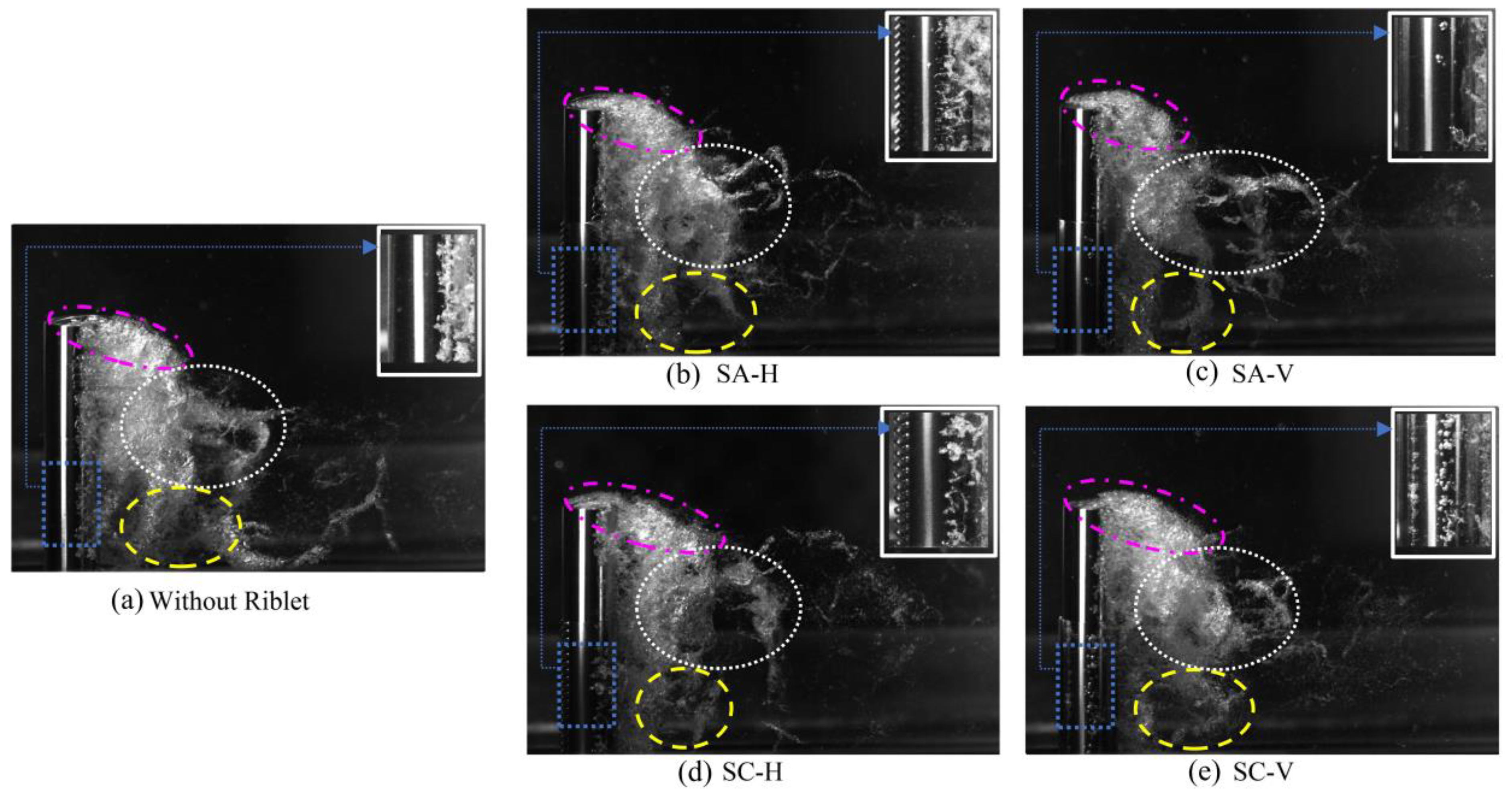




Disclaimer/Publisher’s Note: The statements, opinions and data contained in all publications are solely those of the individual author(s) and contributor(s) and not of MDPI and/or the editor(s). MDPI and/or the editor(s) disclaim responsibility for any injury to people or property resulting from any ideas, methods, instructions or products referred to in the content. |
© 2024 by the authors. Licensee MDPI, Basel, Switzerland. This article is an open access article distributed under the terms and conditions of the Creative Commons Attribution (CC BY) license (https://creativecommons.org/licenses/by/4.0/).
Share and Cite
Kadivar, E.; Dawoodian, M.; Lin, Y.; el Moctar, O. Experiments on Cavitation Control around a Cylinder Using Biomimetic Riblets. J. Mar. Sci. Eng. 2024, 12, 293. https://doi.org/10.3390/jmse12020293
Kadivar E, Dawoodian M, Lin Y, el Moctar O. Experiments on Cavitation Control around a Cylinder Using Biomimetic Riblets. Journal of Marine Science and Engineering. 2024; 12(2):293. https://doi.org/10.3390/jmse12020293
Chicago/Turabian StyleKadivar, Ebrahim, Mazyar Dawoodian, Yuxing Lin, and Ould el Moctar. 2024. "Experiments on Cavitation Control around a Cylinder Using Biomimetic Riblets" Journal of Marine Science and Engineering 12, no. 2: 293. https://doi.org/10.3390/jmse12020293




